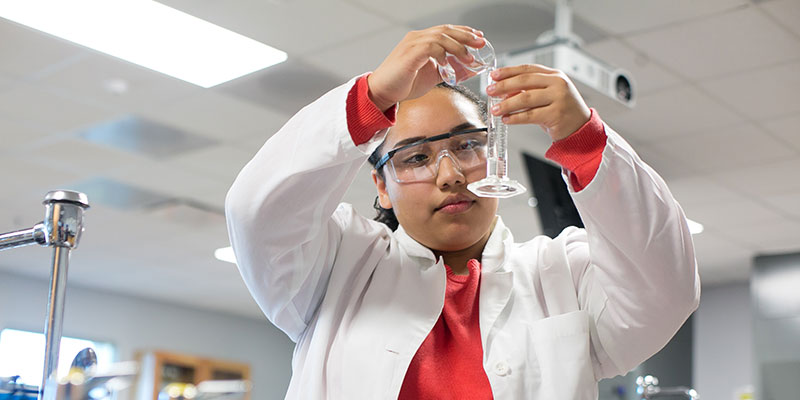B2BMED
Program Goals
Develop a wide pool of research-oriented undergraduates who bridge from STC’s Associate of Science with a field of study in Biology programs to UTRGV’s Bachelor of Science in Biomedical Science Program (BMED). The program will provide support to help students:
- Complete an associate degree and transfer to the UTRGV BMED program
- Complete the UTRGV Bachelor of Science in Biomedical Sciences degree
- Continue to graduate school and/or enter the biomedical science research workforce
Intent to Apply

Application Requirements:
- Must have a GPA of 3.2 or above
- Must have a US citizenship/non-national citizenship or permanent resident status
- Must be a full-time STC student enrolled in Associate of Biology or interdisciplinary programs
- Submit Intent to Apply
- Submit the following documents upon requests:
- Personal statement (1 page single spaced max limit) which discusses the following questions:
- What are your career goals
- What prepared you for this program?
- Why do you want to apply to this program?
- Unofficial STC Transcript
- Resume
- 1 recommendation letter from a science instructor and/or advisor
- Personal statement (1 page single spaced max limit) which discusses the following questions:
- Underrepresented Minorities: All individuals that meet the application requirements can apply, however, we encourage individual from groups that are underrepresented in the biomedical, clinical, behavioral, and social sciences to apply:
- Individuals with disabilities, who are defined as those with a physical or mental impairment that substantially limits one or more major life activities, as described in the Americans with Disabilities Act of 1990, as amended. See NSF data at, https://www.nsf.gov/statistics/2017/nsf17310/static/data/tab7-5.pdf.
- Individuals from disadvantaged backgrounds, defined as those who meet two or more of the following criteria:
- Were or currently are homeless, as defined by the McKinney-Vento Homeless Assistance Act (Definition: https://nche.ed.gov/mckinney-vento/);
- Were or currently are in the foster care system, as defined by the Administration for Children and Families (Definition: https://www.acf.hhs.gov/cb/focus-areas/foster-care);
- Were eligible for the Federal Free and Reduced Lunch Program for two or more years (Definition: https://www.fns.usda.gov/school-meals/income-eligibility-guidelines);
- Have/had no parents or legal guardians who completed a bachelor’s degree (see https://nces.ed.gov/pubs2018/2018009.pdf);
- Were or currently are eligible for Federal Pell grants (Definition: https://www2.ed.gov/programs/fpg/eligibility.html);
- Received support from the Special Supplemental Nutrition Program for Women, Infants and Children (WIC) as a parent or child (Definition: https://www.fns.usda.gov/wic/wic-eligibility-requirements).
- Grew up in one of the following areas: a) a U.S. rural area, as designated by the Health Resources and Services Administration (HRSA) Rural Health Grants Eligibility Analyzer ( https://data.hrsa.gov/tools/rural-health), or b) a Centers for Medicare and Medicaid Services-designated Low-Income and Health Professional Shortage Areas (qualifying zipcodes are included in the file). Only one of the two possibilities in #7 can be used as a criterion for the disadvantaged background definition.
What will the Program provide?
- Mentored research experience (conduct research with a UTRGV faculty or UTRGV and STC faculty team)
- Stipend support (up to $13,367 per year, $1,114 per month)
- Up to 60% of tuition and fees (STC for Year 1 and UTRGV for Year 2)
- Funding support to travel to a national research conference yearly
- Funding support to travel to a summer internship in Year 2
- Multi-level advising and mentoring
- Professionalism workshops
- Summer STEM workshop (math and science)
- Research seminars
What must I do as a B2BMED scholar?
- Apply to UTRGV and register for UTRGV BMED 3121 Independent Research I and BMED 3121 Independent Research II courses for the Fall and Spring of the second year of your associate degree
- Transfer to the UTRGV BMED program after the completion of your associate degree
- Conduct research at UTRGV (10 hours/week for Fall and Spring, 20 hours/week in the summer of 1 st year and 15 hours/week for Fall and Spring of 2 nd year in the B2BMED program)
- Attend summer internship at a research-intensive institution at the end of your 2 nd Year in the B2BMED program
- Attend STEM Workshops
- Attend Professionalism Workshops
- Attend research seminars
- Attend mentoring and advising meetings
- Apply to graduate school
Contacts
UTRGV Contact
Dr. Sue Anne Chew
Email: sueanne.chew@utrgv.edu
STC Contact
Dr. Mehrzad Mahmoudian-Geller
mmahmoud@southtexascollege.edu
956-872-6460
Pecan V1-605F

